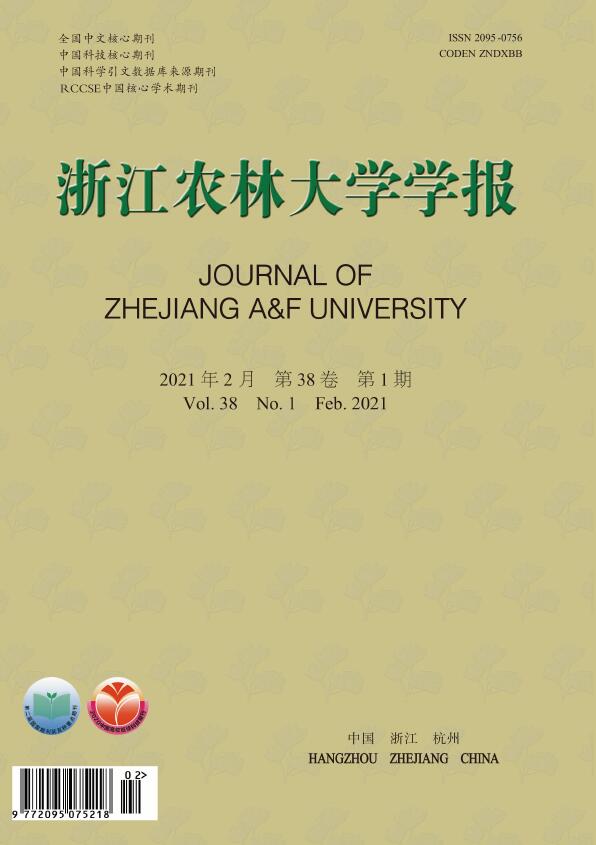-
流式细胞术是指利用流式细胞仪对悬浮细胞或微粒等进行分析的现代分析技术,该技术可对一些特异的细胞和染色体等进行分析和分选,还可对动植物基因组大小及倍性水平等进行测定和分析[1-3]。在分析植物基因组大小过程中,与传统的福尔根染色技术相比,流式细胞术具有速度快、准确性高等优点。因此,目前流式细胞术在植物基因组大小研究中发挥了重要的作用,约265种菊科Asteraceae植物、157种莎草科Cyperaceae植物及191种毛茛属Ranunculus植物的基因组大小已通过流式细胞仪被测定[2, 4-7],大量植物的C值(指单倍体细胞核的DNA含量)数据库已建立[8]。基因组大小信息可为植物系统分类、基因组测序及重测序等研究提供参考,因此,提高植物基因组大小测量精度至关重要[9-10]。竹类植物是重要的森林资源,全世界约119属1 482种,在中国分布的约37属500余种,变种变型100余种[11-13]。在竹类植物基因组学研究中,目前仅有毛竹Phyllostachys edulis、莪莉竹Olyra latifolia、芸香竹Raddia guianensis及瓜多竹Guadua angustifolia等竹种完成了全基因组测序工作,在整个竹类植物中所占比例还不足0.2%[10, 14-15]。另外,在竹类植物基因组大小研究中,目前约200个竹种的基因组大小通过流式细胞仪被测定,但由于不同研究者所用实验内参、仪器类型及实验方法不同,部分竹种在测量结果间存在一定差异[16-19]。流式样品制作主要分为细胞核提取和染色2个步骤,因不同植物细胞内含物及代谢物成分不同,所用细胞核提取液在组成上存在较大差异。研究者们往往会重点关注细胞核提取液,而忽略染色时间对实验结果的影响。因此,为了进一步提高竹类植物基因组大小测定结果的精度,本研究分析了样品采集部位及染色时间对竹类植物基因组大小测定结果的影响,并在此基础上揭示了12个竹种的基因组大小,以期为竹类植物系统分类及基因组测序等提供参考。
HTML
-
以已测序的水稻Oryza sativa为参照。12个竹种清单及采样信息见表1。流式细胞仪分析的植物材料要求是新鲜幼嫩的组织部位,不能进行冷冻和干燥等处理。竹类植物叶片和笋均可满足实验要求,而且方便采集,特别是竹笋更适合长时间保存。唐竹Sinobambusa tootsik、茶竿竹Pseudosasa amabilis var. amabilis、孝顺竹Bambusa multiplex及黄皮刚竹Phyllostachys sulphurea等4个竹种同时以叶片和笋为材料,花叶唐竹Sinobambusa tootisik f. albo-striata、黄皮绿筋竹Phyllostachys sulphurea、平安竹Pseudosasa japonica var. tsutsumiana、柳叶细竹Thyrsostachy ssiamensis、花叶赤竹Sasaella glabra f. albo-striata、美丽箬竹Indocalamus decorus、曙筋矢竹Pseudosasa japonica f. akebono及红秆寒竹Chimonobambusa mamorea f. variegata等8个竹种主要是从国内外一些竹种园收集而来。这些竹种数量有限,目前尚无笋,因此,这8个竹种均以叶片为材料。
竹种 材料来源 经纬度 竹种 材料来源 经纬度 孝顺竹 浙江农林大学翠竹园 30°09′14″N, 119°26′00″E 茶竿竹 浙江农林大学翠竹园 30°09′14″N, 119°26′00″E 柳叶细竹 浙江农林大学智能温室 30°09′14″N, 119°26′00″E 平安竹 浙江农林大学翠竹园 30°09′14″N, 119°26′00″E 黄皮刚竹 浙江农林大学翠竹园 30°09′14″N, 119°26′00″E 曙筋矢竹 浙江农林大学智能温室 30°09′14″N, 119°26′00″E 黄皮绿筋竹 浙江农林大学翠竹园 30°09′14″N, 119°26′00″E 花叶赤竹 浙江农林大学智能温室 30°09′14″N, 119°26′00″E 唐竹 浙江农林大学翠竹园 30°09′14″N, 119°26′00″E 美丽箬竹 浙江农林大学智能温室 30°09′14″N, 119°26′00″E 花叶唐竹 浙江农林大学翠竹园 30°09′14″N, 119°26′00″E 红秆寒竹 浙江农林大学智能温室 30°09′14″N, 119°26′00″E Table 1. Description of the geographical distribution of 12 bamboo species
-
对于竹类植物叶片样品,选取顶端尚未展开的心叶或紧邻心叶已完全展开的嫩叶;对于竹笋样品,选择新鲜无病虫害的嫩笋,实验过程中剥去笋壳。用双面刀片切取一段面积约1 cm2或厚度约1.0 mm的叶片,面积约0.25 cm2的嫩笋置于干净的培养皿中,然后向培养皿中加入500 μL细胞核提取液(cystain UV precise P Nuclei Extraction Buffer,PARTEC,编号5003)润湿样品,用锋利的双面刀片迅速将样品剁碎,将培养皿倾斜静置1~2 min,使细胞核提取充分,之后向培养皿中加入2 mL DAPI (4,6-diamidino-2-phenylindole)染色液(cystain UV precise P stain Buffer,PARTEC,编号5003)对细胞核进行染色,然后用30目的滤头将样品过滤到进样管中,准备上机测样。
-
根据前期多次预实验结果,设置样品染色时间为1、3、5、7、9、12、18、24和30 min共9个梯度,利用流式细胞仪(Partec CyFlow ploidy Analyser)对样品进行测定。为了确保测量结果的准确性,每次实验先以水稻为参照,分析已测序毛竹的基因组大小,在此基础上再对其他竹种基因组大小进行测量和分析。为了减少误差,每个竹种设置3个不同重复,变异系数控制在5%以内。
-
登录C值数据库网站(http://www.rbgkew.org.uk/cval/homepage.html),查出水稻二倍体基因组对应的DNA含量2C为1.0 pg,并推算待测竹种的2C值:待测竹种2C 值 (pg)=(待测竹种峰值/水稻峰值)×水稻2C 值(1.0 pg),水稻单倍体基因组大小为466 Mb[20]。据此可以推算出相应竹种基因组对应的碱基数。
1.1. 材料
1.2. 方法
1.2.1. 流式细胞仪样品制备
1.2.2. 流式细胞仪样品测定
1.2.3. 不同竹种的DNA含量分析
-
利用流式细胞仪测定植物基因组大小过程中,样品峰形状是判断实验结果是否可靠的重要依据。样品处理过程中细胞核提取质量越好,相应的细胞碎片及杂质越少,杂峰就会越少,样品峰往往表现得尖而细,测量误差也较小,实验结果较为可靠;反之,样品处理过程中产生的细胞碎片越多,对应的杂峰也会随之增多,进而影响甚至改变样品峰形状,实验结果往往不可靠。从图1可以看出:孝顺竹、唐竹、茶竿竹及黄皮刚竹等4个竹种叶片和笋所呈现的峰在形状上均尖而细,碎片背景也非常少。另外,同一竹种的叶片和笋对应的峰形和峰值也十分相似,如孝顺竹的叶片和笋均表现出双峰,其中左侧较高的峰为2C细胞所对应的峰,右侧较低的峰为4C细胞所对应的峰,且相同类型细胞对应的荧光强度值也几乎一致(图1A1~A2)。除此之外,唐竹、茶竿竹和黄皮刚竹等3个竹种与孝顺竹情况相似,叶片和笋的测量结果也十分接近(图1B1~B2,图1C1~C2,图1D1~D2)。
理论上,荧光强度值达到最大,说明此时细胞核染色最充分,获得的基因组大小与其真实值也最接近。为了更科学地对竹类植物叶片和笋对应的基因组大小进行比较分析,分别以黄皮刚竹、茶竿竹、孝顺竹及唐竹4个竹种叶片和笋的最大荧光强度值为依据,计算出4个竹种叶片和笋对应的基因组大小。结果表明:4个竹种叶片和笋对应的基因组大小并非完全吻合,唐竹、茶竿竹、孝顺竹及黄皮刚竹叶片对应的2C值分别为(5.03±2.33)、(4.82±0.54)、(2.64±0.50)和(3.76±1.51) pg,而笋对应的2C值分别为(4.99±1.56)、(5.02±1.99)、(2.72±0.59)和(3.86±2.31) pg,其中茶竿竹、孝顺竹及黄皮刚竹叶片2C值略小于笋对应的2C值,差值分别为0.20、0.10和0.08 pg,而唐竹叶片2C值比其笋略大0.04 pg (表2)。虽然4个竹种叶片和笋所获基因组大小并不完全吻合,但是差值非常小,在误差允许范围内。因此,对竹类植物而言其叶片和笋均可作为其基因组大小研究的材料。
物种 材料部位 2C值±标准差/pg 基因组大小±
标准差/Mb水稻 叶片 1.00±0.00 860.00±0.00 唐竹 叶片 5.03±2.33 4 325.80±2.33 笋 4.99±1.56 4 291.40±1.56 茶竿竹 叶片 4.82±0.54 4 145.20±0.54 笋 5.02±1.99 4 317.20±1.99 孝顺竹 叶片 2.64±0.54 2 270.40±0.54 笋 2.72±0.59 2 339.20±0.59 黄皮刚竹 叶片 3.76±1.51 3 233.60±1.51 笋 3.86±2.31 3 319.60±2.31 Table 2. Genome size of leaves and shoots from 4 bamboo species
-
表3表明:12个竹种在一定时间内达到最大荧光强度值后,随着染色时间延长,荧光强度值均有不同程度的减少,当染色时间延长到30 min时,大部分竹种的荧光强度值基本减少到最小。首先,同一竹种的叶片和笋的染色时长及荧光强度变化也不完全相同。以唐竹为例,叶片染色1 min荧光强度即达到最大,之后随着染色时间延长,荧光强度值不断减少,当染色时间延长到30 min时,荧光强度值减少到最小,约减少6.23%,而唐竹笋最大荧光强度则出现在3 min,之后随着染色时间延长,荧光强度不断减少,染色30 min时,其荧光强度减少到119.75±1.40,约减少2.67%(表3和表4)。其次,12个竹种荧光强度在0~30 min也存在较大变化,变异范围为2.67%~12.93%,除唐竹笋、茶竿竹叶和笋、孝顺竹叶及柳叶细竹叶等荧光强度变化小于5%外,其余竹种荧光强度变化值均大于5%,有些竹种荧光强度变化值甚至超过10%,如孝顺竹笋、平安竹叶、花叶赤竹叶及美丽箬竹叶等,荧光强度变化值分别为11.02%、12.93%、12.88%及12.33%等(表4)。表明细胞核染色时间对竹类植物基因组大小测定结果存在一定影响。
物种 部位 不同染色时间对应的荧光强度峰值 1 3 5 7 9 12 18 24 30 min 水稻 叶 24.67±0.38 24.42±0.48 24.2±0.52 24.16±0.42 24.07±0.36 23.94±0.38 23.8±0.34 23.47±0.27 23.15±0.24 唐竹 叶 123.98±2.33 123.32±2.68 122.24±3.14 121.48±3.27 120.81±2.72 119.83±2.84 118.59±3.08 117.32±2.55 116.25±2.19 笋 121.85±1.51 123.04±1.56 122.77±1.23 122.11±1.51 121.86±0.78 120.82±0.35 120.67±0.09 119.75±1.40 119.87±0.60 茶竿竹 叶 118.13±1.24 118.81±0.59 118.97±0.54 118.52±1.03 117.99±0.92 116.27±1.73 115.82±2.62 115.75±2.24 115.31±2.43 笋 123.39±1.90 123.67±2.00 123.75±2.00 123.18±2.09 122.57±1.57 121.37±1.87 119.56±2.31 118.80±1.68 118.85±1.24 孝顺竹 叶 64.07±0.44 65.20±0.54 64.92±0.59 64.63±0.22 64.88±0.44 64.54±0.83 63.85±0.83 63.70±0.86 63.35±0.74 笋 67.22±0.59 66.90±1.15 65.60±1.97 64.72±2.07 63.71±2.90 62.85±3.17 64.79±1.64 60.61±5.90 59.81±6.10 黄皮刚竹 叶 91.20±1.83 92.27±1.60 92.50±1.52 92.70±1.36 92.54±1.36 91.98±1.91 90.64±2.27 90.11±1.93 87.70±1.09 笋 95.21±1.83 95.35±2.31 94.46±3.32 92.72±3.22 92.09±2.81 91.10±2.28 89.01±2.74 88.30±2.03 87.66±1.87 黄皮绿筋竹 叶 95.84±1.19 96.37±0.95 95.66±1.22 95.74±1.23 95.10±1.53 94.68±1.85 93.47±1.81 92.32±2.25 91.27±3.96 平安竹 叶 134.17±0.93 133.44±0.57 132.43±1.18 131.34±1.49 130.17±1.63 129.10±1.93 125.12±4.50 122.36±6.36 116.82±8.22 花叶唐竹 叶 126.61±1.96 125.97±1.71 125.58±2.88 124.25±2.10 123.76±1.86 122.98±2.18 120.92±2.30 118.80±3.17 117.99±2.33 花叶赤竹 叶 132.17±1.58 131.67±1.67 131.36±1.46 129.64±2.47 127.77±3.32 124.73±3.37 122.08±3.05 118.56±3.82 115.14±3.52 曙筋矢竹 叶 141.29±1.85 141.20±1.47 140.06±2.06 139.30±2.20 138.50±1.63 137.64±1.84 135.40±2.90 133.01±2.20 129.62±3.47 美丽箬竹 叶 133.08±1.14 132.59±2.03 130.98±3.10 130.03±2.85 127.63±2.80 125.61±3.61 121.71±4.26 119.82±5.21 116.67±6.85 柳叶细竹 叶 65.67±1.47 65.88±0.83 66.25±1.01 66.23±0.68 66.09±0.40 66.14±0.42 66.39±0.83 65.12±1.47 63.30±0.96 红秆寒竹 叶 132.82±0.97 132.29±1.73 131.62±1.88 131.36±2.02 130.12±2.22 130.10±2.21 127.39±3.91 126.18±3.35 123.87±3.58 Table 3. Mean value under different dyeing time of 12 bamboo species
竹种 材料部位 最大荧光强度 最小荧光强度 荧光强度减少值 变化比例/% 唐竹 叶 123.98±2.33 116.25±2.19 7.73 6.23 笋 123.04±1.56 119.75±1.40 3.29 2.67 茶竿竹 叶 118.97±0.54 115.31±2.43 3.65 3.07 笋 123.75±2.00 118.80±1.68 4.95 4.00 孝顺竹 叶 65.20±0.54 63.35±0.74 1.85 2.84 笋 67.22±0.59 59.81±6.10 7.41 11.02 黄皮刚竹 叶 92.70±1.36 87.70±1.09 5.00 5.39 笋 95.35±2.31 87.66±1.87 7.69 8.07 黄皮绿筋竹 叶 96.37±0.95 91.27±3.96 5.10 5.30 平安竹 叶 134.17±0.93 116.82±8.22 17.35 12.93 花叶唐竹 叶 126.61±1.96 117.99±2.33 8.62 6.81 花叶赤竹 叶 132.17±1.58 115.14±3.52 17.03 12.88 曙筋矢竹 叶 141.29±1.85 129.62±3.47 11.67 8.26 美丽箬竹 叶 133.08±1.14 116.67±6.85 16.41 12.33 柳叶细竹 叶 66.39±0.83 63.30±0.96 2.95 4.45 红秆寒竹 叶 132.82±0.97 123.87±3.58 8.95 6.74 Table 4. Fluorescence intensity change of 12 bamboos
另外,不同竹种甚至同一竹种不同组织部位对染色时间反应也不完全相同。以叶片材料为例,唐竹、花叶唐竹、平安竹、曙筋矢竹、美丽箬竹、花叶赤竹及红秆寒竹染色1 min即达到最大荧光强度,染色时间延长到3 min时,荧光强度略有衰减,但减少不明显(表3);孝顺竹和黄皮绿筋竹最大荧光强度出现在3 min,但与1、5 min对应的荧光强度相差不明显(表3);茶竿竹和柳叶细竹最大荧光强度出现在5 min,其中茶竿竹最大荧光强度与其3 min时的荧光强度最接近,而柳叶细竹最大荧光强度与其7 min时的荧光强度最接近,只有黄皮刚竹最大荧光强度出现在7 min,但与5、9 min对应的峰值十分接近(表3)。以笋为材料时,荧光强度随染色体时间变化情况与叶片相似,其中孝顺竹的笋最大荧光强度出现在1 min,唐竹和黄皮刚竹2个竹种笋的最大荧光强度出现在3 min,茶竿竹最大荧光强度出现在5 min (表3)。唐竹、茶竿竹、孝顺竹和黄皮刚竹4个竹种同时以叶片和笋为材料,但是叶片和笋对应的荧光曲线图也不完全相同,例如黄皮刚竹笋的最大荧光强度出现在3 min,叶片最大荧光强度却出现在7 min (表3)。综上所述,无论是叶片还是竹笋,当染色时间延长到3 min时,75%的竹种已达到最大荧光强度值,延长到5 min时,已有91.67%的竹种达到最大荧光强度值。因此,为确保竹类植物基因组大小测定结果的准确性,竹类植物染色时间最好控制在7 min以内,以3~5 min最佳。
-
表5表明:孝顺竹和柳叶细竹对应的基因组大小分别为(2.64±0.54)和(2.69±1.01) pg,明显小于其他10个竹种;其次为刚竹属Phyllostachys的黄皮刚竹和黄皮绿筋竹,对应的2C值分别为(3.76±1.51)和(3.91±0.95) pg,明显小于其他一些竹属的竹种;再次为唐竹属Sinobambusa的唐竹和花叶唐竹,对应的基因组大小分别为(5.03±2.33)和(5.13±1.96) pg。赤竹属Sasaella的花叶赤竹、箬竹属Indocalamus的美丽箬竹及寒竹属Chimonobambusa的红秆寒竹3个竹种基因组大小比较相近,对应的基因组大小分别为(5.36±1.58)、(5.39±1.14)和(5.38±0.97) pg。茶竿竹、平安竹和曙筋矢竹在分类上虽然为同一属,但彼此间差异较大,这3个竹种的基因组大小分别为(4.82±0.54)、(5.44±0.93)和(5.73±1.85) pg。
物种 2C值±标准差/pg 基因组大小±标准差/Mb 物种 2C值±标准差/pg 基因组大小±标准差/Mb 水稻 1.00±0.00 860.00±0.00 茶竿竹 4.82±0.54 4 145.20±0.54 孝顺竹 2.64±0.54 2 270.40±0.54 平安竹 5.44±0.93 4 678.40±0.93 柳叶细竹 2.69±1.01 2 313.40±1.01 曙筋矢竹 5.73±1.85 4 927.80±1.85 黄皮刚竹 3.76±1.51 3 233.60±1.51 花叶赤竹 5.36±1.58 4 609.60±1.58 黄皮绿筋竹 3.91±0.95 3 362.60±0.95 美丽箬竹 5.39±1.14 4 635.40±1.14 唐竹 5.03±2.33 4 325.80±2.33 红秆寒竹 5.38±0.97 4 626.80±0.97 花叶唐竹 5.13±1.96 4 411.80±1.96 说明:以12个竹种叶片对应的最大荧光强度值为依据,对其基因组大小进行了计算 Table 5. Genome size of 12 different bamboo species
2.1. 竹类植物叶片和笋基因组大小测量结果分析
2.2. 染色时间对竹类植物基因组大小测定结果的影响
2.3. 12个不同属种竹种的基因组大小分析
-
KUMAR等[18]研究表明:分布在新加坡的孝顺竹基因组大小为(3.11±0.02) pg,而ZHOU等[19]研究表明:分布在中国的孝顺竹基因组大小为(2.78±0.02) pg。本研究中孝顺竹叶片和笋对应的基因组大小分别为(2.64±0.54)和(2.72±0.59) pg,与ZHOU等[19]研究结果较为接近,与KUMAR等[18]研究结果存在一定差异。流式细胞仪测定植物基因组大小过程中,细胞核提取液种类、染色液浓度、染色液类型及染色时间等均会对基因组大小测定结果产生一定影响[21-23]。KUMAR等[18]以烟草Nicotiana tabacum为对照,采用碘化丙啶(PI)荧光染料对细胞核进行染色,为了去除烟草等植物细胞中一些特殊的内含物,细胞核提取液中加入了一定量的聚乙烯吡咯烷酮(PVP)。如果PVP浓度过大,在一定程度上会影响细胞核与荧光染料的结合,进而影响细胞核染色效果[24]。本研究与ZHOU等[19]的实验方法相似,均以水稻为对照,用DAPI对细胞核进行染色,这可能是本研究结果与ZHOU等[19]较为接近而与KUMAR等[18]有差异的主要原因。另外,本研究中红秆寒竹和茶竿竹对应的基因组大小分别为(5.38±0.97)和(4.82±0.54) pg,比ZHOU等[19]研究的2个竹种的基因组略大。这种差异可能是由于染色时间不同而造成的。本研究表明:染色时间对竹类植物基因组大小测定结果存在一定影响,且不同竹种对染色时间要求并不完全相同,大部分竹种的细胞核可以被快速染色,如红秆寒竹、美丽箬竹及曙筋矢竹等1 min即可达到最大荧光值;还有少量竹种染色较慢,如茶竿竹和黄皮刚竹等需5~7 min才可达到最大荧光值。ZHOU等[19]对竹类植物基因组大小进行分析过程中,所有竹种均采用相同的染色时间,这可能是造成这种差异的主要原因。
利用流式细胞仪分析植物基因组大小过程时,一般需要选择基因组大小已知的物种做对照,然后根据流式细胞仪测量结果对待测物种基因组大小进行估算[24-25]。对照物种选择一般需遵循以下几个原则:①对照物种已测序,且基因组大小与待测物种基因组大小间存在显著差异,以便区分对照峰和样品峰;②对照样品与待测样具有一定的生物学相似性;③对照材料方便采集且易大量获取。目前,虽然毛竹、莪莉竹、芸香竹及瓜多竹等已完成测序[10, 14-15],但其中大部分竹种主要分布在南方热带地区,这些竹种在经过长时间、长距离运输后,部分材料萎蔫或者细胞核结构改变已达不到实验要求。为了检测不同对照对竹类植物基因组大小测定结果是否存在影响,本研究尝试同时利用水稻和毛竹为参照,对孝顺竹、柳叶竹、黄皮刚竹、黄皮绿筋竹、唐竹及曙筋矢竹等竹种基因组大小进行比较分析,表明2种参照所获基因组大小十分接近,但由于毛竹基因组大小与待测竹种黄皮刚竹、黄皮绿筋竹、茶竿竹及唐竹等竹种的基因组相差较小,因此测量过程中对照毛竹的峰和待测竹种的峰间存在较大区域的重叠和干扰。水稻与竹类植物同属禾本科Poaceae,其种子通过催芽2~3周即可获得大量嫩苗,另外水稻与竹类植物基因组大小相差约3~6倍,测量过程中对照峰和样品峰区分非常明显,彼此间干扰较少。因此,对竹类植物而言水稻是非常理想的参照物。
竹类植物主要分为草本竹种和木本竹种2个基本类型。根据分布区域,木本竹种又分为温带木本竹种和热带木本竹种2个类型[11,26]。温带木本竹种染色体数目比较稳定,基本上为2n=48(2n代表体细胞染色体数,即是单倍体的2倍),热带木本竹种染色体数目表现比较复杂,主要有2n=64,2n=70±2,2n=96,2n=104等多种类型[19, 27-29]。本研究所分析的12个木本竹种中,孝顺竹和柳叶细竹为热带木本竹种,黄皮刚竹、黄皮绿筋竹、唐竹、花叶唐竹、茶竿竹、平安竹、曙筋矢竹、花叶赤竹、美丽箬竹及红秆寒竹均为温带木本竹种。本研究表明:12个木本竹种基因组大小与染色体数目并不呈正相关,虽然孝顺竹和柳叶细竹2个竹种染色体数目多于另外10个温带木本竹种,但基因组大小却明显小于温带木本竹种,这与一些温带竹种和热带竹种研究的情况类似[16, 18-19, 25]。部分竹种测序结果表明:竹类植物是异源多倍体植物,基因组主要分为A、B、C和D等4个不同的亚基因组,长期进化过程中C基因组竹种分别与B和D基因组竹种杂交形成染色体组类型分别为BBCC和CCDD的异源四倍体竹种(2n=48),之后A基因组竹种又与基因组类型为BBCC的异源四倍体竹种杂交形成染色体组类型为AABBCC的异源六倍体竹种(2n=72)[14]。本研究中:黄皮刚竹、黄皮绿筋竹、唐竹、花叶唐竹、茶竿竹、平安竹、曙筋矢竹、花叶赤竹、美丽箬竹及红秆寒竹等温带竹种虽然染色体数目相同,但基因组大小却存在较大差异,2C值为3.76~5.73 pg,相差近1.52倍。这些竹种中,刚竹属的黄皮刚竹和黄皮绿筋竹对应的基因组大小分别为(3.76±1.51)和(3.91±0.95) pg,明显小于其他竹属中的一些竹种。另外,唐竹属、矢竹属、赤竹属、箬竹属及寒竹属中的一些竹种在基因组大小上差异不大,特别是花叶刺竹、美丽箬竹及红秆寒竹3个竹种基因组大小十分接近。因此,根据12个不同竹种的基因组大小测定结果推测,赤竹属、箬竹属及寒竹属等属竹种在染色体组组成类型上可能相同或相近,与刚竹属竹种在染色体组类型上存在较大差异。











 DownLoad:
DownLoad: